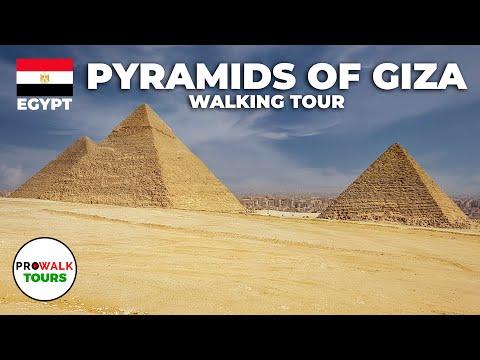I had always been fascinated by ancient history and the grandeur of lost civilizations, so when I finally found myself standing at the foot of the Pyramids of Giza, it felt surreal. The early morning sun was just beginning to cast its golden light over the landscape, and the cool desert air had a crispness that hinted at the mysteries lying ahead. I had joined a walking tour, eager to explore these colossal monuments up close and to unravel the secrets that had fascinated humanity for centuries.
Our guide, Ahmed, greeted us with a warm smile and a wave. His eyes sparkled with an enthusiasm that was contagious. “Welcome, everyone,” he said, his voice rich with a blend of authority and excitement. “Today, we embark on a journey through time, walking among the giants of antiquity. The Pyramids of Giza are not just structures; they are the very essence of ancient Egyptian civilization.”
As we began our walk, the first thing that struck me was the sheer scale of the pyramids. The Great Pyramid, known as Khufu’s Horizon, stood towering above us. Its sheer size was overwhelming, and I could hardly believe that humans, thousands of years ago, had managed to construct such a massive edifice without the advanced technology we have today. Ahmed explained that it was originally built as a tomb for Pharaoh Khufu, around 2580 BC. The precision with which the pyramid was constructed still baffles experts; it was aligned almost perfectly with the cardinal points and built with an accuracy that defied the technology of the time.
As we approached the pyramid, I marveled at the massive limestone blocks that comprised its outer casing. Each block was meticulously cut and placed, and despite the centuries of erosion, the craftsmanship was evident. Ahmed pointed out that the stones were transported from quarries miles away and that the construction was a feat of logistics and engineering. I could almost picture the ancient workers, their faces flushed with exertion, their muscles straining as they maneuvered the enormous blocks into place.
We continued our walk around the pyramid, making our way towards the smaller pyramids nearby, which served as tombs for Khufu’s queens and other high-ranking officials. The contrast between the massive Great Pyramid and these smaller, yet still impressive, structures highlighted the significance of the primary tomb. The smaller pyramids had their own charm, with intricate hieroglyphs and remnants of vibrant paintings that spoke of a bygone era. Ahmed explained the symbolism behind the art, illustrating how these decorations were meant to ensure a comfortable afterlife for the deceased.
One of the most intriguing parts of the tour was our visit to the Sphinx, the mythical creature with the body of a lion and the head of a Pharaoh. Standing in front of the Sphinx, I felt a sense of awe and reverence. Ahmed shared the legend of the Sphinx, which had puzzled historians for centuries. It was believed to represent the Pharaoh Khafre, whose pyramid stood behind it. The Sphinx’s enigmatic smile and serene gaze seemed to challenge the passage of time itself, inviting us to ponder the mysteries of its origins and purpose.
As we walked, Ahmed took us to a vantage point where we could view all three pyramids from a single location. The sight was nothing short of breathtaking. The pyramids, arranged in a precise alignment, seemed to be a deliberate attempt to connect with the heavens. Ahmed explained the significance of their positioning, relating it to the ancient Egyptians’ beliefs about the afterlife and the gods. The pyramids were not merely tombs; they were cosmic symbols, meant to bridge the earthly realm with the divine.
The tour also included a visit to the Solar Boat Museum, which housed the reconstructed boat of Pharaoh Khufu. This boat, discovered buried near the Great Pyramid, was an incredible find. It was believed that it would be used by the Pharaoh in the afterlife to journey across the heavens. Seeing the boat in person was like stepping into a time capsule, offering a glimpse into the ceremonial practices and beliefs of ancient Egypt. The craftsmanship of the boat, with its finely carved wood and intricate details, was a testament to the skill and artistry of the ancient builders.
As the sun climbed higher in the sky, casting long shadows over the desert sands, our group made our way back to the starting point of the tour. The experience had been both enlightening and humbling. Walking among these ancient wonders, I felt a profound connection to the past and a deeper appreciation for the incredible achievements of the ancient Egyptians. The Pyramids of Giza were not just historical artifacts; they were living symbols of human ambition, ingenuity, and reverence for the cosmos.
As I left the site, I couldn’t help but reflect on the stories Ahmed had shared, the legends and facts that had brought these ancient structures to life. The Pyramids of Giza, with their majestic presence and enigmatic aura, had left an indelible mark on my soul. The walking tour had not only allowed me to see these wonders up close but had also given me a renewed sense of wonder and respect for the ancient world.
